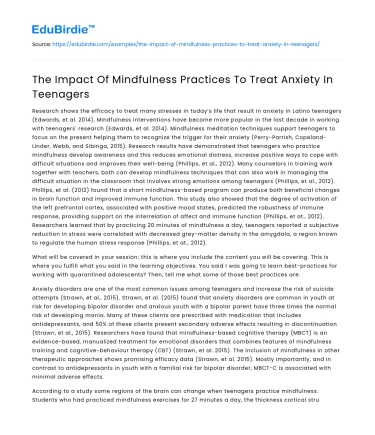Introduction
In recent years, the prevalence of anxiety among teenagers has been rising alarmingly, with a significant increase in cases reported by various mental health organizations. The pressures of academic performance, social expectations, and an ever-connected digital world are significant contributors. Traditional treatments for anxiety, such as medication and talk therapy, have proven effective but often come with side effects or accessibility challenges. Consequently, there is a growing interest in alternative approaches, particularly mindfulness practices, as a means to manage anxiety in teenagers. Mindfulness, rooted in Buddhist traditions, involves maintaining a moment-by-moment awareness of thoughts, feelings, bodily sensations, and the surrounding environment. This essay explores the impact of mindfulness practices on treating anxiety in teenagers by examining their effectiveness, potential mechanisms, and supporting evidence from real-life cases and studies.
The Effectiveness of Mindfulness Practices
Mindfulness practices have gained considerable attention for their potential to alleviate anxiety symptoms among teenagers. A study conducted by Biegel et al. (2009) demonstrated that mindfulness-based stress reduction (MBSR) significantly reduced anxiety levels in adolescents. Participants reported improvements in their ability to focus and a reduction in stress-related symptoms such as insomnia and irritability. The practice of mindfulness encourages individuals to focus on the present moment, which can reduce rumination, a common feature of anxiety. By fostering a nonjudgmental awareness of one's thoughts and feelings, mindfulness can help teenagers develop a healthier relationship with their internal experiences.
Real-life cases further illustrate the benefits of mindfulness for teenagers with anxiety. For instance, a pilot program in a high school in California integrated mindfulness sessions into the curriculum. Students who participated reported feeling calmer and more equipped to handle stressors both in and out of school. One student mentioned, "I used to always worry about upcoming exams, but now I focus on the present, and it has made a huge difference." Such anecdotal evidence supports the growing body of research advocating for the inclusion of mindfulness practices in educational settings as a feasible intervention for teenage anxiety.
Mechanisms Underlying Mindfulness Benefits
The mechanisms through which mindfulness alleviates anxiety symptoms in teenagers involve both psychological and physiological processes. Neurological studies have shown that mindfulness practices can lead to significant changes in brain structure and function. For example, research by Hölzel et al. (2011) found that mindfulness meditation can increase the density of gray matter in areas of the brain associated with emotional regulation and self-referential processing. These changes can help teenagers better manage anxiety by enhancing emotional resilience and reducing the tendency to engage in negative thought patterns.
Furthermore, mindfulness practices have been linked to reductions in the stress hormone cortisol. A study by Turakitwanakan et al. (2013) found that participants who engaged in regular mindfulness meditation exhibited lower levels of cortisol, suggesting a physiological basis for the reduction in anxiety symptoms. This biological evidence complements the psychological benefits and highlights the multifaceted impact of mindfulness on the adolescent brain and body. Thus, mindfulness not only addresses the cognitive aspects of anxiety but also offers a holistic approach by influencing physiological stress responses.
Counterarguments and Limitations
Despite the promising evidence supporting mindfulness as a treatment for anxiety in teenagers, some experts argue that it may not be suitable for everyone. Critics point out that mindfulness requires a level of introspection and commitment that some teenagers may find challenging. Furthermore, the effectiveness of mindfulness can vary depending on the individual's level of engagement and the quality of instruction. As Kabat-Zinn (2013), a pioneer in mindfulness research, noted, "Mindfulness is not a miracle cure; it requires consistent practice and a willingness to face one's own discomfort."
Additionally, some researchers caution against over-reliance on mindfulness as a standalone treatment. They argue that it should be integrated into a broader therapeutic framework that includes cognitive-behavioral techniques and social support systems. This holistic approach can address the multifaceted nature of anxiety and cater to the diverse needs of teenagers. By acknowledging these limitations, we can better appreciate the role of mindfulness within the context of comprehensive mental health care for adolescents.
Conclusion
In conclusion, mindfulness practices offer a promising avenue for alleviating anxiety in teenagers. With evidence supporting their effectiveness and mechanisms that cater to both psychological and physiological aspects of anxiety, mindfulness presents a holistic and accessible approach. While acknowledging the limitations and potential challenges, integrating mindfulness into broader therapeutic frameworks can enhance its efficacy. As mental health issues continue to rise among adolescents, the inclusion of mindfulness practices in education and therapy can equip teenagers with valuable tools to manage anxiety and improve their overall well-being. As society continues to seek effective solutions for mental health challenges, mindfulness stands out as a viable and beneficial practice for the younger generation.






 Stuck on your essay?
Stuck on your essay?

